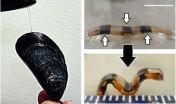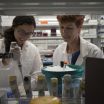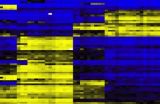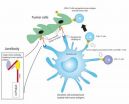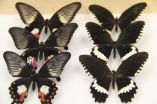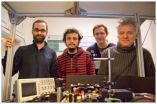(Press-News.org) Protein from a small, tasty mollusk inspired Michigan Technological University's Bruce P. Lee to invent a new type of hydrogel actuator.
Hydrogels are soft networks of polymers with high water content, like jello. Because of their soft, gentle texture, they have the potential to interact safely with living tissues and have applications in a number of medical areas, including tissue engineering. Lee, an assistant professor of biomedical engineering, wanted to make a hydrogel that wouldn't just sit there.
"Hydrogels that can change shape on command could be used to deliver pharmaceuticals," he said. "We've taken a hydrogel and made it into an actuator: something that can change shape or move, maybe by opening the door for a drug and letting it out."
To make his movable hydrogel, Lee borrowed chemistry from proteins that mussels use to anchor themselves to wet rocks. A component in that protein, DOPA (for 3,4-dihydroxyphenylalanine), has unusual properties shared by its chemical cousin, dopamine, and it was dopamine that Lee incorporated into their hydrogel.
He started with a dopamine-suffused hydrogel shaped like a thick, short stick of gum. Next, he laid an iron rod across it in three places, each time running a charge through the rod to release iron ions onto the hydrogel's surface. Finally, he raised the hydrogel's pH.
The hydrogel moved on its own, bending like an inchworm where the ions had been deposited.
Lee explains: At an acid pH, only one side chain on the dopamine molecules attaches to the iron ions. "But if you raise the pH, three dopamine side chains converge to grab the one ion," he said. "That makes all the molecules come together, so the hydrogel shrinks in that spot, causing it to bend where the ions are."
A hydrogel could be programmed to adopt all manner of shapes by changing the placement of the ions, the composition of the hydrogel and the voltage. You can also remove the ions and reintroduce them in a different pattern, so that the same hydrogel can be reprogrammed to transform into a different shape.
"You can make it almost like a claw, so at some point it might even be able to pick things up," Lee said. "The body is slightly alkaline, so perhaps it could be loaded with a drug and introduced into the body, where it could release the drug. And maybe it could be designed to respond to other stimuli, like temperature."
Other scientists have used metal ions to make hydrogel actuators, but no one has used chemistry found in mussel adhesive proteins. Lee hopes to follow up on his initial discovery.
"Right now, our hydrogel actuator is slow and takes some time to bend," he said. "We need to study it more, and we also want to try it with other ions, like titanium and copper."
INFORMATION:A paper describing the work, "Novel Hydrogel Actuator Inspired by Reversible Mussel Adhesive Protein Chemistry," coauthored by Lee and undergraduate Shari Konst, was published online March 4 in Advanced Materials.
Pumping iron: A hydrogel actuator with mussel tone
Technique could lead to new drug delivery system
2014-03-05
ELSE PRESS RELEASES FROM THIS DATE:
Going viral to target tumors
2014-03-05
March 5, 2014, New York, NY– A Ludwig Cancer Research study suggests that the clinical efficacy of checkpoint blockade, a powerful new strategy to harness the immune response to treat cancers, might be dramatically improved if combined with oncolytic virotherapy, an investigational intervention that employs viruses to destroy tumors.
Published today in the journal Science Translational Medicine, the study evaluated a combination therapy in which the Newcastle disease virus (NDV), a bird virus not ordinarily harmful to humans, is injected directly into one of two melanoma ...
Biomarkers of cell death in Alzheimer's reverse course after symptom onset
2014-03-05
Three promising biomarkers being studied to detect Alzheimer's disease in its early stages appear to undergo a surprising shift as patients develop symptoms of dementia, researchers at Washington University School of Medicine in St. Louis report.
Scientists use the biomarkers to assess brain changes linked to the disease in research volunteers. The levels of markers of neuronal injury increase in the spinal fluid for a decade or more before the onset of dementia, but in a new twist, the research shows for the first time that they later reverse course, decreasing as symptoms ...
An inventive new way to profile immune cells in blood
2014-03-05
ROVIDENCE, R.I. [Brown University] — When a person becomes sick or is exposed to an unwelcome substance, the body mobilizes specific proportions of different immune cells in the blood. Methods of discovering and detecting those profiles are therefore useful both clinically and in research. In a new paper in the journal Genome Biology, a team of scientists describes a new and uniquely advantageous way to detect them.
All the current means of counting immune cells in a blood sample require whole cells, said Karl Kelsey, professor of epidemiology at Brown and corresponding ...
Novel cancer vaccine holds promise against ovarian cancer, mesothelioma
2014-03-05
A novel approach to cancer immunotherapy – strategies designed to induce the immune system to attack cancer cells – may provide a new and cost-effective weapon against some of the most deadly tumors, including ovarian cancer and mesothelioma. Investigators from the Massachusetts General Hospital (MGH) Vaccine and Immunotherapy Center report in the Journal of Hematology & Oncology that a protein engineered to combine a molecule targeting a tumor-cell-surface antigen with another protein that stimulates several immune functions prolonged survival in animal models of both ...
Hungry for 'likes': Frequent Facebook use linked to eating disorder risk, study finds
2014-03-05
TALLAHASSEE, Fla. — Frequent Facebook users might be sharing more than party pictures, vacation videos and shameless selfies — they also share a greater risk of eating disorders, according to a new study led by Florida State University researchers.
Psychology Professor Pamela K. Keel studied 960 college women and found that more time on Facebook was associated with higher levels of disordered eating. Women who placed greater importance on receiving comments and "likes" on their status updates and were more likely to untag photos of themselves and compare their own photos ...
Prenatal nicotine exposure may lead to ADHD in future generations
2014-03-05
TALLAHASSEE, Fla. — Prenatal exposure to nicotine could manifest as attention deficit hyperactivity disorder in children born a generation later, according to a new study by Florida State University College of Medicine researchers.
Professors Pradeep G. Bhide and Jinmin Zhu have found evidence that ADHD associated with nicotine can be passed across generations. In other words, your child's ADHD might be an environmentally induced health condition inherited from your grandmother, who may have smoked cigarettes during pregnancy a long time ago. And the fact that you never ...
A single gene, doublesex, controls wing mimicry in butterflies
2014-03-05
A single gene regulates the complex wing patterns, colors and structures required for mimicry in swallowtail butterflies, report scientists from the University of Chicago, March 5 in Nature. Surprisingly, the gene described, doublesex, is already well-known for its critical role in sexual differentiation in insects.
"Conventional wisdom says that it should be multiple genes working together to control the whole wing pattern of a butterfly," said Marcus Kronforst, Neubauer Family Assistant Professor of Ecology & Evolution at the University of Chicago and senior author ...
Ultra sensitive detection of radio waves with lasers
2014-03-05
Radio waves are used for many measurements and applications, for example, in communication with mobile phones, MRI scans, scientific experiments and cosmic observations. But 'noise' in the detector of the measuring instrument limits how sensitive and precise the measurements can be. Now researchers at the Niels Bohr Institute have developed a new method where they can avoid noise by means of laser light and can therefore achieve extreme precision of measurements. The results are published in the prestigious scientific journal, Nature.
'Noise' in the detector of a measuring ...
Livestock can produce food that is better for the people and the planet
2014-03-05
With one in seven humans undernourished, and with the challenges of population growth and climate change, the need for efficient food production has never been greater. Eight strategies to cut the environmental and economic costs of keeping livestock, such as cows, goats and sheep, while boosting the quantity and quality of the food produced have been outlined by an international team of scientists.
The strategies to make ruminant - cud-chewing - livestock a more sustainable part of the food supply, led by academics at the University of Bristol's School of Veterinary ...
ALS-linked gene causes disease by changing genetic material's shape
2014-03-05
Johns Hopkins researchers say they have found one way that a recently discovered genetic mutation might cause two nasty nervous system diseases. While the affected gene may build up toxic RNA and not make enough protein, the researchers report, the root of the problem seems to be snarls of defective genetic material created at the mutation site.
The research team, led by Jiou Wang, Ph.D., an assistant professor of biochemistry and molecular biology and neuroscience at the Johns Hopkins University School of Medicine, reports its finding March 5 on the journal Nature's ...
LAST 30 PRESS RELEASES:
The Ceramic Society of Japan’s Oxoate Ceramics Research Association launches new international book project
Heart-brain connection: international study reveals the role of the vagus nerve in keeping the heart young
Researchers identify Rb1 as a predictive biomarker for a new therapeutic strategy in some breast cancers
Survey reveals ethical gaps slowing AI adoption in pediatric surgery
Stimulant ADHD medications work differently than thought
AI overestimates how smart people are, according to HSE economists
HSE researchers create genome-wide map of quadruplexes
Scientists boost cell "powerhouses" to burn more calories
Automatic label checking: The missing step in making reliable medical AI
Low daily alcohol intake linked to 50% heightened mouth cancer risk in India
American Meteorological Society announces Rick Spinrad as 2026 President-Elect
Biomass-based carbon capture spotlighted in newly released global climate webinar recording
Illuminating invisible nano pollutants: advanced bioimaging tracks the full journey of emerging nanoscale contaminants in living systems
How does age affect recovery from spinal cord injury?
Novel AI tool offers prognosis for patients with head and neck cancer
Fathers’ microplastic exposure tied to their children’s metabolic problems
Research validates laboratory model for studying high-grade serous ovarian cancer
SIR 2026 delivers transformative breakthroughs in minimally invasive medicine to improve patient care
Stem Cell Reports most downloaded papers of 2025 highlight the breadth and impact of stem cell research
Oxford-led study estimates NHS spends around 3% of its primary and secondary care budget on the health impacts of heat and cold in England
A researcher’s long quest leads to a smart composite breakthrough
Urban wild bees act as “microbial sensors” of city health.
New study finds where you live affects recovery after a hip fracture
Forecasting the impact of fully automated vehicle adoption on US road traffic injuries
Alcohol-related hospitalizations from 2016 to 2022
Semaglutide and hospitalizations in patients with obesity and established cardiovascular disease
Researchers ‘listen in’ to embryo-mother interactions during implantation using a culture system replicating the womb lining
How changing your diet could help save the world
How to make AI truly scalable and reliable for real-time traffic assignment?
Beyond fragmented markets: A new framework for efficient and stable ride-pooling
[Press-News.org] Pumping iron: A hydrogel actuator with mussel toneTechnique could lead to new drug delivery system
